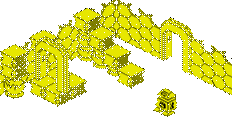Atari Jaguar
Vital Statistics
![]()
What's it like today?
|
In 1991, Atari began working on a new 32-bit console, codenamed 'Panther'. This new console was to compete directly with the Sega Mega Drive (Genesis), the forthcoming Super Nintendo (SNES), and the Panasonic 3DO. However, in December 1992 Atari announced the Panther project was to be cancelled and work to be refocussed on a 64-bit console which they had been working on in parallel with 'Panther', codenamed 'Jaguar'.
Initially planned for a debut in Summer 1993, rumours spread quickly regarding the high specification level of the new machine, in particular the 64-bit RISC microprocessor at its heart. Atari at the time disclosed a rough price of between $100 and $150 for the new console. It finally launched in August 1993 to a couple of test markets in the USA - New York City and the San Francisco Bay Area, following a $500M manufacturing deal with IBM. At launch the suggested retail price had risen to $200, and by the time it hit the stores in October this price had gone up again, to $250. Despite this, and reports from the industry's critics that Atari couldn't support the Jaguar, it sold out almost instantly. Atari had managed to get around twenty third-party software houses to agree to develop games for the Jaguar.
Technically, the Jaguar was way ahead of its competitors, with 5 processors built into 3 chips - a Motorola 68000 and two proprietary chips called Tom and Jerry. Tom was an advanced Graphics Processor chip, while Jerry handled the Digital Signal Processing, both running on a 64-bit bus.
Unfortunately, these software houses discovered that the Jaguar was very difficult to develop games for, and this resulted in many delays to titles, while other titles were rushed out of the door in a bid to keep the product's momentum. These games were often considered below par by the media and gaming public.
Following poor sales over Christmas 1994, it was becoming clear that Sony's new Playstation would win the battle of the consoles, despite it being technically far inferior. Through to the end of 1995, Atari had sold approximately 125,000 units of Jaguar, and as of December 31, 1995, Atari still had approximately 100,000 unsold units of Jaguar in their inventory.
 Atari continued to push the Jaguar, releasing peripherals including the Jaguar CD-ROM drive and the ProController, until it's reverse-merger with JT Storage in June 1996. Part of the merger agreement was that JTS would keep the Atari business operational. After they sold off all the stock, JTS were targeted for investigation by the SEC and quickly sold Atari on to Hasbro Interactive for $5m in the late 1990s. Following this, Hasbro released the rights to the Jaguar, declaring the console an open platform and opening the doors for homebrew development. Several developers, including Telegames and Songbird Productions, have not only released previously unfinished materials from the Jaguar's past, but also several brand new titles to satisfy the system's cult following.
Atari continued to push the Jaguar, releasing peripherals including the Jaguar CD-ROM drive and the ProController, until it's reverse-merger with JT Storage in June 1996. Part of the merger agreement was that JTS would keep the Atari business operational. After they sold off all the stock, JTS were targeted for investigation by the SEC and quickly sold Atari on to Hasbro Interactive for $5m in the late 1990s. Following this, Hasbro released the rights to the Jaguar, declaring the console an open platform and opening the doors for homebrew development. Several developers, including Telegames and Songbird Productions, have not only released previously unfinished materials from the Jaguar's past, but also several brand new titles to satisfy the system's cult following.
In the United Kingdom in 2001, a deal was struck between Telegames and retailer Game to bring the Jaguar to Game's retail outlets. The machine was initially sold for £29.99 brand new and the software was ranged between £9.99 for more common games such as Doom and Ruiner Pinball, and up to £39.99 for more sought-after releases such as Defender 2000 and Checkered Flag. The machine had a presence in the stores until 2007 when remaining consoles were sold off for £9.99 and games were sold for as low as 97p. This deal was seen as a move to remain competitive with Game's rival at the time, Gamestation, who were well known for stocking retro formats.
The Jaguar continues to have a small and dedicated game development circle.
Launch titles




US launch titles: Cybermorph and Trevor McFur in the Crescent Galaxy
.jpg)

European and Japanese launch title: Alien vs. Predator




Japanese launch titles: Doom and Wolfenstein 3D











